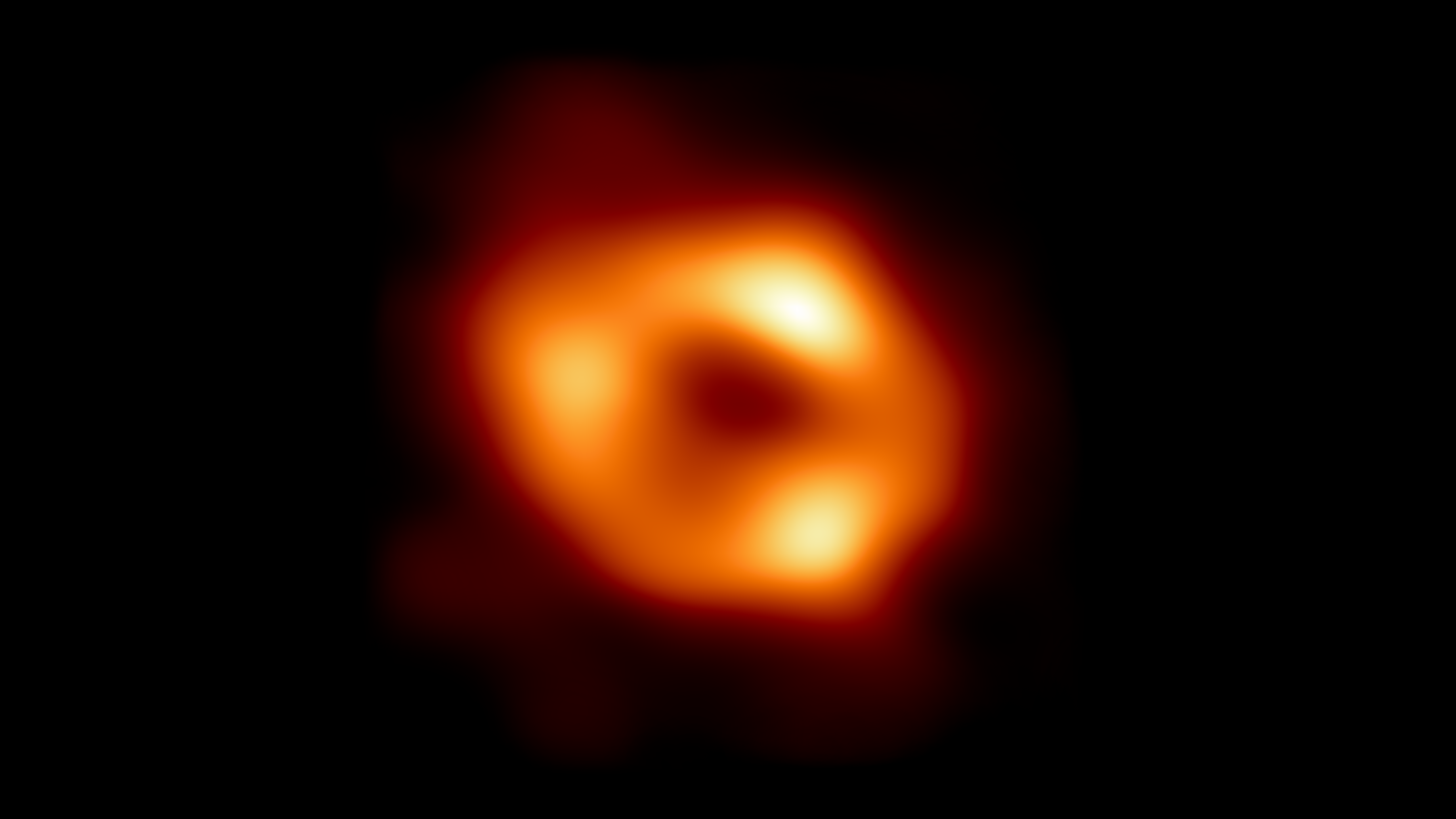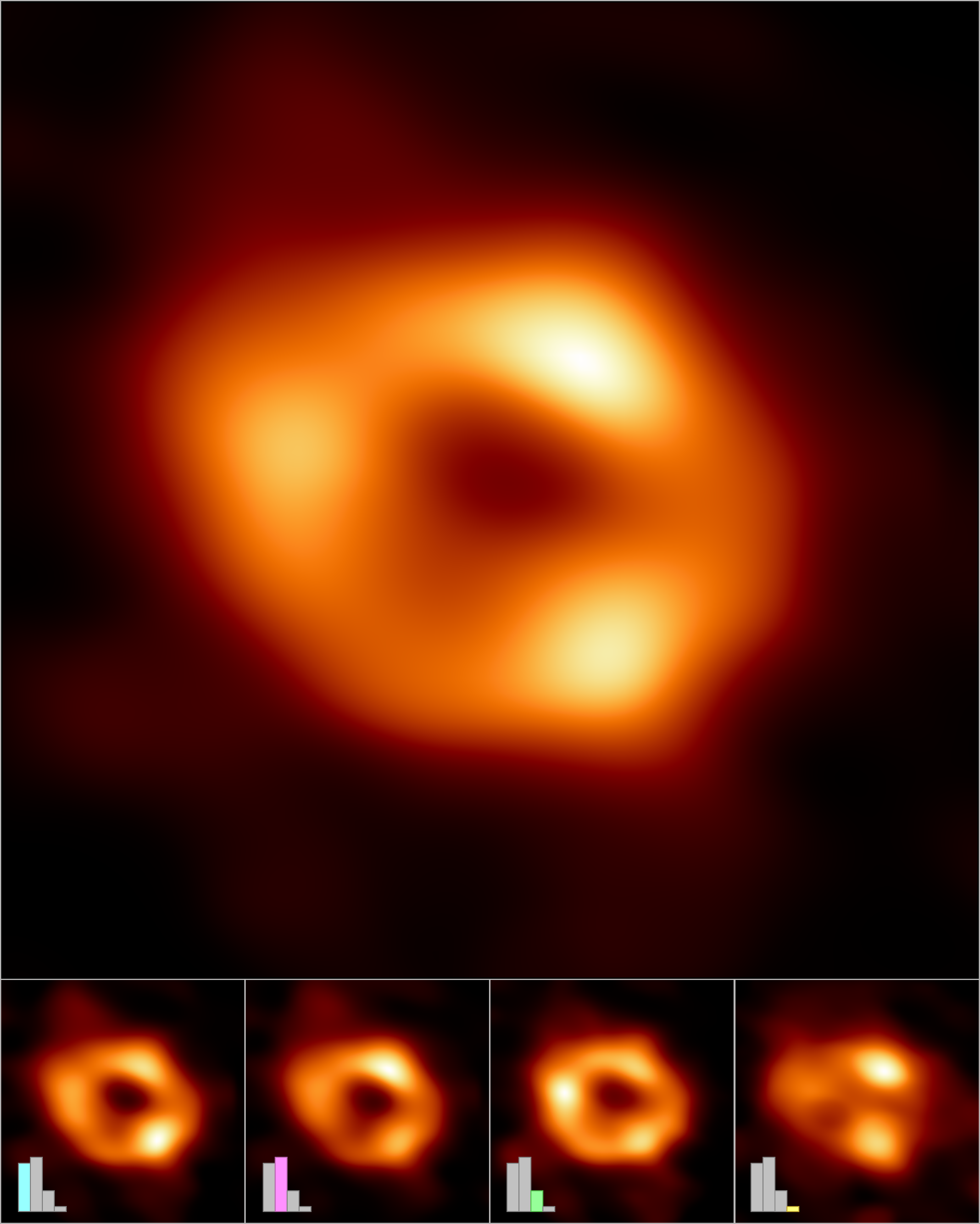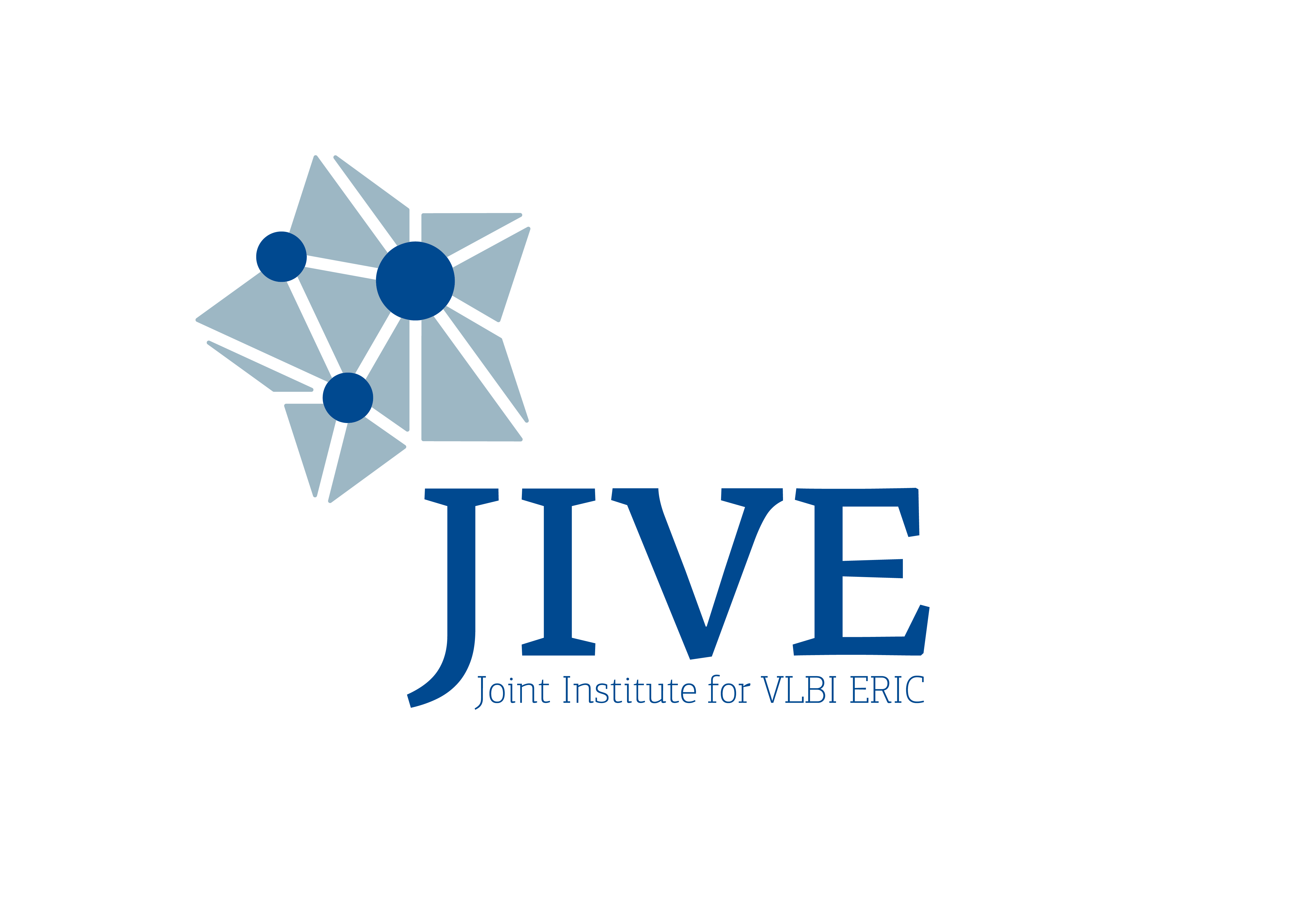
Astronomers have unveiled the first image of the supermassive black hole at the centre of our own Milky Way galaxy. This result provides overwhelming evidence that the object is indeed a black hole and yields valuable clues about the workings of such giants, which are thought to reside at the centre of most galaxies. The image was produced by a global research team called the Event Horizon Telescope (EHT) Collaboration - including participation in the Netherlands of astronomers and technicians from University of Amsterdam, Radboud University, Leiden University, University of Groningen, JIVE ERIC and ASTRON - using observations from a worldwide network of radio telescopes. The image has been unveiled by JIVE Chief Scientist and EHT Project Director Huib Jan van Langevelde at the European Southern Observatory Headquarters in Garching (Germany), one of the press conferences organised by the EHT Collaboration around the world.
First direct evidence of a Black Hole at SgrA*
The image is a long-anticipated look at the massive object that sits at the very centre of our galaxy. Scientists had previously seen stars orbiting around something invisible, compact, and very massive at the centre of the Milky Way. This strongly suggested that this object — known as Sagittarius A* (Sgr A*, pronounced "sadge-ay-star") — is a black hole, and today’s image provides the first direct visual evidence of it.
Although we cannot see the black hole itself, because it is completely dark, glowing gas around it reveals a telltale signature: a dark central region (called a “shadow”) surrounded by a bright ring-like structure. The new view captures light bent by the powerful gravity of the black hole, which is four million times more massive than our Sun.
“We were stunned by how well the size of the ring agreed with predictions from Einstein’s Theory of General Relativity," said EHT Project Scientist Geoffrey Bower from the Institute of Astronomy and Astrophysics, Academia Sinica, Taipei. "These unprecedented observations have greatly improved our understanding of what happens at the very centre of our galaxy, and offer new insights on how these giant black holes interact with their surroundings.” The EHT team's results are being published today in a special issue of The Astrophysical Journal Letters.
Because the black hole is about 27,000 light-years away from Earth, it appears to us to have about the same size in the sky as a donut on the Moon. To image it, the team created the powerful EHT, which linked together eight existing radio observatories across the planet to form a single “Earth-sized” virtual telescope [1]. The EHT observed Sgr A* on multiple nights, collecting data for many hours in a row, similar to using a long exposure time on a camera.
Remarkably similar
The breakthrough follows the EHT collaboration’s 2019 release of the first image of a black hole, called M87*, at the centre of the more distant Messier 87 galaxy.
The two black holes look remarkably similar, even though our galaxy’s black hole is more than a thousand times smaller and less massive than M87* [2]. "We have two completely different types of galaxies and two very different black hole masses, but close to the edge of these black holes they look amazingly similar,” says Sera Markoff, Co-Chair of the EHT Science Council and a professor of theoretical astrophysics at the University of Amsterdam, the Netherlands. "This tells us that General Relativity governs these objects up close, and any differences we see further away must be due to differences in the material that surrounds the black holes.”
This achievement was considerably more difficult than for M87*, even though Sgr A* is much closer to us. EHT scientist Chi-kwan (‘CK’) Chan, from Steward Observatory and Department of Astronomy and the Data Science Institute of the University of Arizona, US, explains: “The gas in the vicinity of the black holes moves at the same speed — nearly as fast as light — around both Sgr A* and M87*. But where gas takes days to weeks to orbit the larger M87*, in the much smaller Sgr A* it completes an orbit in mere minutes. This means the brightness and pattern of the gas around Sgr A* was changing rapidly as the EHT Collaboration was observing it — a bit like trying to take a clear picture of a puppy quickly chasing its tail.”
The researchers had to develop sophisticated new tools that accounted for the gas movement around Sgr A*. While M87* was an easier, steadier target, with nearly all images looking the same, that was not the case for Sgr A*. The image of the Sgr A* black hole is an average of the different images the team extracted (see secondary image below), finally revealing the giant lurking at the centre of our galaxy for the first time.

Already predicted 20 years ago
The effort was made possible through the ingenuity of more than 300 researchers from 80 institutes around the world that together make up the EHT Collaboration. In addition to developing complex tools to overcome the challenges of imaging Sgr A*, the team worked rigorously for five years, using supercomputers to combine and analyse their data, all while compiling an unprecedented library of simulated black holes to compare with the observations.
In 2000, Heino Falcke, EHT board member and professor of astroparticle physics and radio astronomy at Radboud University, the Netherlands, came up with the term ‘black hole shadow’, describing how the black hole diverges the light of the surrounding glowing gas cloud. He predicted that it should be possible to image a black hole using radio telescopes. Together with Sera Markoff, he made the first calculations of the radiation of this black hole. “Now, it seems that the predictions that we made 20 years ago are now confirmed”, says Markoff.
As part of their involvement in the EHT Collaboration, JIVE researchers have been essential for the calibration of the EHT data that resulted in the imaging of the black hole at the centre of our galaxy. “The work at JIVE has resulted in entirely new software being used to verify and improve the calibration of EHT observations. This is key for the EHT science, where you need your instrument to be absolutely 100% robust”, says JIVE Scientist and EHT Collaboration member Ilse van Bemmel.
"JIVE, an European Research Infrastructure, has the role to continuously deliver VLBI expertise, robust data and services to the worldwide radio astronomy community, fostering innovation that makes possible breakthrough science such as this new superb result of the EHT collaboration", says JIVE ERIC Director Francisco Colomer.
Two black holes imaged
Scientists are particularly excited to finally have images of two black holes of very different sizes, which offers the opportunity to understand how they compare and contrast. They have also begun to use the new data to test theories and models of how gas behaves around supermassive black holes. This process is not yet fully understood but is thought to play a key role in shaping the formation and evolution of galaxies.
“Now we can study the differences between these two supermassive black holes to gain valuable new clues about how this important process works,” said EHT scientist Keiichi Asada from the Institute of Astronomy and Astrophysics, Academia Sinica, Taipei. “We have images for two black holes — one at the large end and one at the small end of supermassive black holes in the Universe — so we can go a lot further in testing how gravity behaves in these extreme environments than ever before.”
Progress on the EHT continues: a major observation campaign in March 2022 included more telescopes than ever before. The ongoing expansion of the EHT network and significant technological upgrades will allow scientists to share even more impressive images as well as movies of black holes in the near future. Radboud University, together with the University of Namibia, is developing the Africa Millimetre Telescope (AMT) on the Gamsberg mountain in Namibia. The AMT telescope, which is expected in 2026, is a crucial addition to the EHT network for making dynamic images of black holes.
"My first VLBI observations with the European VLBI Network some 30 years ago targeted the Galactic centre at long wavelengths, showing that the interstellar medium blurred the image. Now with millimetre VLBI we can resolve the shadow of the black hole. How exciting is that?", says JIVE Chief Scientist and EHT Project Director Huib Jan van Langevelde.
Notes
[1] The individual telescopes involved in the EHT in April 2017, when the observations were conducted, were: the Atacama Large Millimetre/submillimetre Array (ALMA), the Atacama Pathfinder Experiment (APEX), the IRAM 30-metre Telescope, the James Clerk Maxwell Telescope (JCMT), the Large Millimetre Telescope Alfonso Serrano (LMT), the Submillimeter Array (SMA), the UArizona Submillimeter Telescope (SMT), the South Pole Telescope (SPT). Since then, the EHT has added the Greenland Telescope (GLT), the NOrthern Extended Millimeter Array (NOEMA) and the UArizona 12-metre Telescope on Kitt Peak to its network.
ALMA is a partnership of the European Southern Observatory (ESO; Europe, representing its member states), the U.S. National Science Foundation (NSF), and the National Institutes of Natural Sciences (NINS) of Japan, together with the National Research Council (Canada), the Ministry of Science and Technology (MOST; Taiwan), Academia Sinica Institute of Astronomy and Astrophysics (ASIAA; Taiwan), and Korea Astronomy and Space Science Institute (KASI; Republic of Korea), in cooperation with the Republic of Chile. The Joint ALMA Observatory is operated by ESO, the Associated Universities, Inc./National Radio Astronomy Observatory (AUI/NRAO) and the National Astronomical Observatory of Japan (NAOJ). APEX, a collaboration between the Max Planck Institute for Radio Astronomy (Germany), the Onsala Space Observatory (Sweden) and ESO, is operated by ESO. The 30-meter Telescope is operated by IRAM (the IRAM Partner Organizations are MPG (Germany), CNRS (France) and IGN (Spain)). The JCMT is operated by the East Asian Observatory on behalf of the Center for Astronomical Mega-Science of the Chinese Academy of Sciences, NAOJ, ASIAA, KASI, the National Astronomical Research Institute of Thailand, and organizations in the United Kingdom and Canada. The LMT is operated by INAOE and UMass, the SMA is operated by Center for Astrophysics | Harvard & Smithsonian and ASIAA and the UArizona SMT is operated by the University of Arizona. The SPT is operated by the University of Chicago with specialized EHT instrumentation provided by the University of Arizona.
The Greenland Telescope (GLT) is operated by ASIAA and the Smithsonian Astrophysical Observatory (SAO). The GLT is part of the ALMA-Taiwan project, and is supported in part by the Academia Sinica (AS) and MOST. NOEMA is operated by IRAM and the UArizona 12-meter telescope at Kitt Peak is operated by the University of Arizona.
[2] Black holes are the only objects we know of where mass scales with size. A black hole a thousand times smaller than another is also a thousand times less massive.
Additional Information
The EHT consortium consists of 13 stakeholder institutes; the Academia Sinica Institute of Astronomy and Astrophysics, the University of Arizona, the Centre for Astrophysics | Harvard & Smithsonian, the University of Chicago, the East Asian Observatory, Goethe-Universitaet Frankfurt, Institut de Radioastronomie Millimétrique, Large Millimetre Telescope, Max Planck Institute for Radio Astronomy, MIT Haystack Observatory, National Astronomical Observatory of Japan, Perimeter Institute for Theoretical Physics, and Radboud University.
The Joint Institute for VLBI ERIC (JIVE) has as its primary mission to operate and develop the European VLBI Network (EVN) data processor, a powerful supercomputer that combines the signals from radio telescopes located across the planet. Founded in 1993, JIVE is since 2015 a European Research Infrastructure Consortium (ERIC) with seven member countries: France, Italy, Latvia, the Netherlands, United Kingdom, Spain and Sweden; additional support is received from partner institutes in China, Germany and South Africa. JIVE is hosted by the Netherlands Institute for Radio Astronomy (ASTRON) in the Netherlands.
Images
Main Image: First image of the black hole at the centre of the Milky Way
Caption: This is the first image of Sagittarius A* (or Sgr A* for short), the supermassive black hole at the centre of our galaxy. It’s the first direct visual evidence of the presence of this black hole. It was captured by the Event Horizon Telescope (EHT), an array which linked together eight existing radio observatories across the planet to form a single “Earth-sized” virtual telescope. The telescope is named after the “event horizon”, the boundary of the black hole beyond which no light can escape.
Although we cannot see the event horizon itself, because it cannot emit light, glowing gas orbiting around the black hole reveals a telltale signature: a dark central region (called a “shadow”) surrounded by a bright ring-like structure. The new view captures light bent by the powerful gravity of the black hole, which is four million times more massive than our Sun. The image of the Sgr A* black hole is an average of the different images the EHT Collaboration has extracted from its 2017 observations.
Credit: EHT Collaboration
Secondary Image: Making of the image of the black hole at the centre of the Milky Way
The Event Horizon Telescope (EHT) Collaboration has created a single image (top frame) of the supermassive black hole at the centre of our galaxy, called Sagittarius A* (or Sgr A* for short), by combining images extracted from the EHT observations.
The main image was produced by averaging together thousands of images created using different computational methods — all of which accurately fit the EHT data. This averaged image retains features more commonly seen in the varied images, and suppresses features that appear infrequently.
The images can also be clustered into four groups based on similar features. An averaged, representative image for each of the four clusters is shown in the bottom row. Three of the clusters show a ring structure but, with differently distributed brightness around the ring. The fourth cluster contains images that also fit the data but do not appear ring-like.
The bar graphs show the relative number of images belonging to each cluster. Thousands of images fell into each of the first three clusters, while the fourth and smallest cluster contains only hundreds of images. The heights of the bars indicate the relative "weights," or contributions, of each cluster to the averaged image at top.
Credit: EHT Collaboration
Publications
The EHT team's results are being published in a special issue of The Astrophysical Journal Letters.
Those are the six collaboration papers
- First Sagittarius A* Event Horizon Telescope Results. I. The Shadow of the Supermassive Black Hole in the Center of the Milky Way, Event Horizon Telescope Collaboration et al., The Astrophysical Journal Letters, vol. TBD, doi: 10.3847/2041-8213/ac6674 and https://iopscience.iop.org/article/10.3847/2041-8213/ac6674
- First Sagittarius A* Event Horizon Telescope Results. II. EHT and Multi-wavelength Observations, Data Processing, and Calibration, Event Horizon Telescope Collaboration et al., The Astrophysical Journal Letters, vol. TBD, doi: 10.3847/2041-8213/ac6675 and https://iopscience.iop.org/article/10.3847/2041-8213/ac6675
- First Sgr A∗ Event Horizon Telescope Results. III. Imaging of the Galactic Center Supermassive Black Hole, Event Horizon Telescope Collaboration et al., The Astrophysical Journal Letters, vol. TBD, doi: 10.3847/2041-8213/ac6429 and https://iopscience.iop.org/article/10.3847/2041-8213/ac6429
- First Sagittarius A* Event Horizon Telescope Results. IV. Variability, Morphology, and Black Hole Mass, Event Horizon Telescope Collaboration et al., The Astrophysical Journal Letters, vol. TBD, doi: 10.3847/2041-8213/ac6736 and https://iopscience.iop.org/article/10.3847/2041-8213/ac6736
- First Sagittarius A* Event Horizon Telescope Results. V. Testing Astrophysical Models of the Galactic Center Black Hole, Event Horizon Telescope Collaboration et al., The Astrophysical Journal Letters, vol. TBD, doi:: 10.3847/2041-8213/ac6672 and https://iopscience.iop.org/article/10.3847/2041-8213/ac6672
- First Sagittarius A* Event Horizon Telescope Results VI: Testing the Black Hole Metric, Event Horizon Telescope Collaboration et al., The Astrophysical Journal Letters, vol. TBD, doi: 10.3847/2041-8213/ac6756 and https://iopscience.iop.org/article/10.3847/2041-8213/ac6756
Here the four official papers:
- Selective Dynamical Imaging of Interferometric Data, Joseph Farah, Peter Galison, Kazunori Akiyama, et al., The Astrophysical Journal Letters, vol. TBD: doi: 10.3847/2041-8213/ac6615 and https://iopscience.iop.org/article/10.3847/2041-8213/ac6615
- Millimeter Light Curves of Sagittarius A* Observed during the 2017 Event Horizon Telescope Campaign, Maciek Wielgus, Nichola Marchili, Iván Martí-Vidal, et al., The Astrophysical Journal Letters, vol. TBD: doi: 10.3847/2041-8213/ac6428 and https://iopscience.iop.org/article/10.3847/2041-8213/ac6428
- A Universal Power Law Prescription for Variability from Synthetic Images of Black Hole Accretion Flows, Boris Georgiev, Dominic W. Pesce, Avery E. Broderick, et al., The Astrophysical Journal Letters, vol. TBD: doi: 10.3847/2041-8213/ac65eb and https://iopscience.iop.org/article/10.3847/2041-8213/ac65eb
- Characterizing and Mitigating Intraday Variability: Reconstructing Source Structure in Accreting Black Holes with mm-VLBI, Avery E. Broderick, Roman Gold, Boris Georgiev, et al., The Astrophysical Journal Letters, vol. TBD: doi: 10.3847/2041-8213/ac6584 and https://iopscience.iop.org/article/10.3847/2041-8213/ac6584
Links
- EHT website: https://eventhorizontelescope.org/
- Background Material: https://www.jive.eu/sites/default/files/shared/news/EHT-Background-Material-May-2022.pdf
- More information, images and videos on the ESO website: https://www.eso.org/public/djangoplicity/login/?next=/public/news/eso2208-eht-mw/
- All members of the EHT based in the Netherlands: https://www.ru.nl/astrophysics/black-hole/event-horizon-telescope-collaboration-0/members-eht-collaboration-netherlands/
- BlackHoleCam website: www.blackholecam.org
Contacts
Geoffrey Bower
EHT Project Scientist
Institute of Astronomy and Astrophysics, Academic Sinica, Taipei
Tel: +1-808-961-2945
Email: gbower@asiaa.sinica.edu.tw
Huib Jan van Langevelde
EHT Project Director,
JIVE ERIC and University of Leiden, The Netherlands
Mobile: +31-62120 1419
Email: langevelde@jive.eu
Ilse M. van Bemmel
JIVE Project Scientist
Joint Institute for VLBI ERIC (JIVE)
Phone: +31-62288 5267 (mobile)
Email: bemmel@jive.eu
Jorge Rivero González
JIVE Science Communications Officer
Joint Institute for VLBI ERIC (JIVE)
Email: rivero@jive.eu
